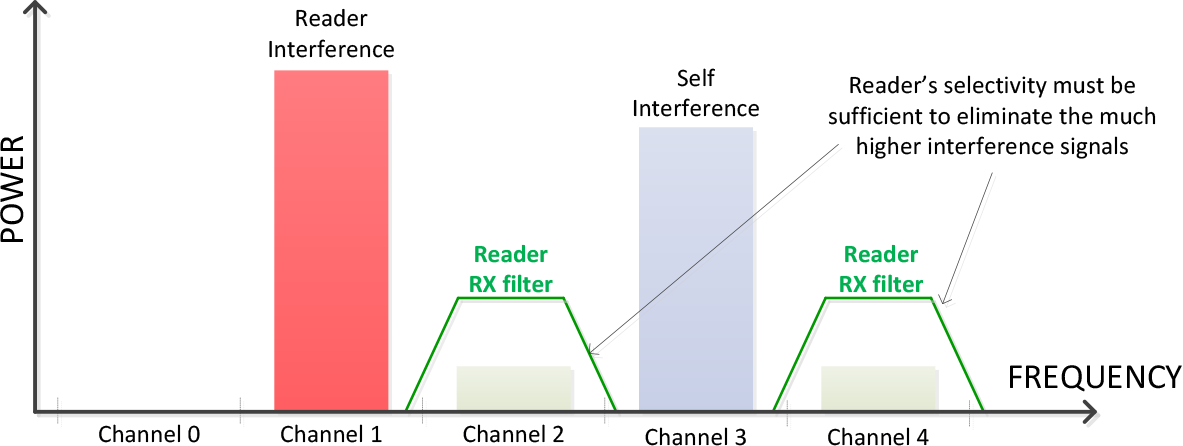Dense Reader Performance
When multiple readers are operating simultaneously in the same facility, two nearby readers will receive each other’s transmit signal much louder than the signal of nearby tags.
RAIN RFID is defined in the GS1 RAIN standard. The RAIN standard defines how readers near one another should operate. This is known as the “dense interrogator” or “dense reader” environment: when multiple readers are operating simultaneously in the same facility.
Dense reader operation is challenging because two nearby readers will receive each other’s transmit signal much louder than they hear nearby tags, illustrated in Figure 1. The figure shows two readers separated by 50 meters, both broadcasting radio signals to inventory tags. Reader 1 is communicating with a tag 5 meters away, but Reader 2’s radio signal is simultaneously being received by Reader 1. In fact, Reader 2’s interfering signal can be 100,000 times more powerful than the tag signal which Reader 1 is trying to decode.
The dense reader problem illustrated in Figure 1 is why the RAIN standard goes out of its way to define and specify dense reader operation. However, the RAIN standard only specifies transmitter performance. The receiver performance is completely unspecified in the standard. If your reader is not able to handle the interference, you will have poor dense reader performance. To understand dense reader performance, one needs to understand why all that interference is challenging in the receiver.
Sensitivity
Sensitivity is the minimum received tag signal power to reliably decode the signal. Reader sensitivity can be 10 picowatts (-80dBm) or even less. A reader can decode such low-level signals because it uses amplifiers in the receiver to boost the signal before the ADC digitally samples it for processing in the reader’s modem. Figure 2 shows this in a conventional RFID radio.
The receive signal path is illustrated along the top of Figure 2. The reader’s radio will typically employ gain amplifiers (“amp”) at UHF and baseband. Readers should use very linear amplifiers and a high dynamic range ADC and must manage amplifier gain to maximize sensitivity subject to interference.
Articles RA1009 and RA1010 are tutorials on what “very linear amplifiers” and “dynamic range/gain management” means, respectively. For this article we’ll just say the amplifiers can be overdriven by the reader interference, leading to compression or clipping. Linearity is a measure of amplifier fidelity. This is particularly important when an amplifier must faithfully amplify and reproduce a low-level tag signal while being subjected to much larger interference. Dynamic range is a measure of the largest-to-smallest level signal an ADC can simultaneously resolve while not clipping due to the largest signal. Linearity and Dynamic Range are two properties that directly affect the reader’s dense reader performance.
Selectivity
Selectivity is best understood in terms of frequency channels, as in broadcast radio or TV stations. The operating frequency spectrum is divided up into channels. The idea in RAIN RFID dense reader mode is that readers use odd numbered channels to transmit to the tags and tags respond on the two adjacent even channels, as shown in Figure 3. Figure 3 shows the reader transmitting on channel 3, with a tag responding on channels 2 and 4. Figure 3 also shows a nearby reader on channel 1.
When the tag channels are translated to baseband for amplification and modem processing as shown in Figure 2, the receiver and modem must filter out any reader interference signals on any of the odd channels. The combined signal processing of the radio and modem must filter out reader interference to a low enough level it is reduced to the noise floor required for the reader’s specified sensitivity. The selectivity required for dense reader performance is enabled by radio performance in Figure 2 with most receive channel filtering handled by the modem.
Note that Figure 3 also shows the reader’s self-interference on channel 3. This is an unavoidable result of the tags using backscatter communications. The topic of self-interference is an important one in RAIN RFID, and what you don’t know may be hurting your solution performance. Article RA1011 covers the topic of self-interference is detail.
Summary
When the raw throughput and coverage of dense fixed reader deployments are needed, then dense reader performance is critical to success. Dense reader performance is dependent on good radio linearity and dynamic range, plus a highly selective receive channel filter in the modem.
Clairvoyant’s Telepathy S1 RFID reader achieves -85dBm sensitivity in low interference environments, but also maintains a remarkable -80dBm sensitivity with a -10dBm adjacent or co-channel interfering reader. This is critical information when deploying in industrial IoT, warehouses, supply chain dock doors, or any application demanding high throughput and dense coverage. How does your reader compare?


